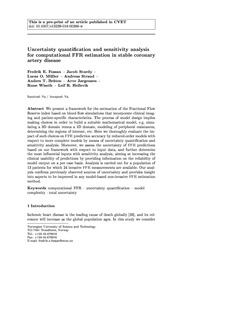| dc.contributor.author | Fossan, Fredrik Eikeland | |
| dc.contributor.author | Sturdy, Jacob | |
| dc.contributor.author | Muller, Lucas Omar | |
| dc.contributor.author | Strand, Andreas | |
| dc.contributor.author | Bråten, Anders Tjellaug | |
| dc.contributor.author | Jørgensen, Arve | |
| dc.contributor.author | Wiseth, Rune | |
| dc.contributor.author | Hellevik, Leif Rune | |
| dc.date.accessioned | 2019-10-16T13:02:48Z | |
| dc.date.available | 2019-10-16T13:02:48Z | |
| dc.date.created | 2018-11-28T11:16:40Z | |
| dc.date.issued | 2018 | |
| dc.identifier.citation | Cardiovascular Engineering and Technology. 2018, 9 (4), 597-622. | nb_NO |
| dc.identifier.issn | 1869-408X | |
| dc.identifier.uri | http://hdl.handle.net/11250/2622598 | |
| dc.description.abstract | Purpose
The main objectives of this study are to validate a reduced-order model for the estimation of the fractional flow reserve (FFR) index based on blood flow simulations that incorporate clinical imaging and patient-specific characteristics, and to assess the uncertainty of FFR predictions with respect to input data on a per patient basis.
Methods
We consider 13 patients with symptoms of stable coronary artery disease for which 24 invasive FFR measurements are available. We perform an extensive sensitivity analysis on the parameters related to the construction of a reduced-order (hybrid 1D–0D) model for FFR predictions. Next we define an optimal setting by comparing reduced-order model predictions with solutions based on the 3D incompressible Navier–Stokes equations. Finally, we characterize prediction uncertainty with respect to input data and identify the most influential inputs by means of sensitivity analysis.
Results
Agreement between FFR computed by the reduced-order model and by the full 3D model was satisfactory, with a bias (FFR3D−FFR1D−0DFFR3D−FFR1D−0D) of −0.03(±0.03)−0.03(±0.03) at the 24 measured locations. Moreover, the uncertainty related to the factor by which peripheral resistance is reduced from baseline to hyperemic conditions proved to be the most influential parameter for FFR predictions, whereas uncertainty in stenosis geometry had greater effect in cases with low FFR.
Conclusion
Model errors related to solving a simplified reduced-order model rather than a full 3D problem were small compared with uncertainty related to input data. Improved measurement of coronary blood flow has the potential to reduce uncertainty in computational FFR predictions significantly. | nb_NO |
| dc.language.iso | eng | nb_NO |
| dc.publisher | Springer Verlag | nb_NO |
| dc.title | Uncertainty quantification and sensitivity analysis for computational FFR estimation in stable coronary artery disease | nb_NO |
| dc.type | Journal article | nb_NO |
| dc.type | Peer reviewed | nb_NO |
| dc.description.version | acceptedVersion | nb_NO |
| dc.source.pagenumber | 597-622 | nb_NO |
| dc.source.volume | 9 | nb_NO |
| dc.source.journal | Cardiovascular Engineering and Technology | nb_NO |
| dc.source.issue | 4 | nb_NO |
| dc.identifier.doi | 10.1007/s13239-018-00388-w | |
| dc.identifier.cristin | 1636303 | |
| dc.relation.project | Notur/NorStore: NN9545K | nb_NO |
| dc.description.localcode | This is a post-peer-review, pre-copyedit version of an article published in [Cardiovascular Engineering and Technology] Locked until 31.10.2019 due to copyright restrictions. The final authenticated version is available online at: https://doi.org/10.1007/s13239-018-00388-w | nb_NO |
| cristin.unitcode | 194,64,45,0 | |
| cristin.unitcode | 194,65,25,0 | |
| cristin.unitcode | 1920,6,0,0 | |
| cristin.unitcode | 1920,4,0,0 | |
| cristin.unitname | Institutt for konstruksjonsteknikk | |
| cristin.unitname | Institutt for sirkulasjon og bildediagnostikk | |
| cristin.unitname | Klinikk for hjertemedisin | |
| cristin.unitname | Klinikk for bildediagnostikk | |
| cristin.ispublished | true | |
| cristin.fulltext | preprint | |
| cristin.fulltext | postprint | |
| cristin.qualitycode | 1 | |
